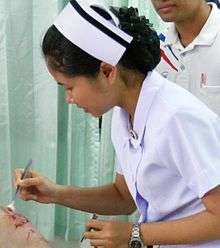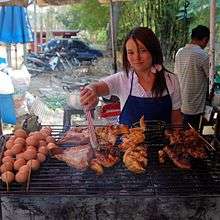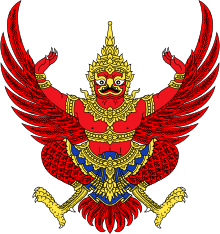Women in Thailand
 A female nurse in Thailand | |
| Gender Inequality Index | |
|---|---|
| Value | 0.360 (2012) |
| Rank | 66th |
| Maternal mortality (per 100,000) | 48 (2010) |
| Women in parliament | 15.7% (2012) |
| Females over 25 with secondary education | 29.0% (2010) |
| Women in labour force | 63.8% (2011) |
| Global Gender Gap Index[1] | |
| Value | 0.6928 (2013) |
| Rank | 65th out of 144 |

.jpg)
Women in Thailand were among the first women in Asia who were granted the right to vote in 1932. They are underrepresented in Thai politics.[2][3] Yingluck Shinawatra, a woman, was prime minister from 2011 to 2014. The roles of women in Thailand's national development has not yet been fully established. Factors that affect women's participation in the socio-economic field include "inadequate gender awareness in the policy and planning process" and social stereotyping.[4]
Politics
Despite of the absence of legal limitations to women participating in the politic arena of Thailand, the factors that have impeded the rise of women in political activities include structural barriers, cultural impediments, lower educational attainments, lower socio-economic status,[4][5] and power-sharing issues with the opposite sex.[4] It was only on June 5, 1949 that Orapin Chaiyakan became the first woman to be elected to hold a post in the National Assembly of the Kingdom of Thailand (specifically, the House of Representatives.[2][3])
The first female army officer to be elected to political office in Thailand was Lt. Col. Thita Manitkul (2001-2005).
Business
In the realm of entrepreneurship, Thailand's female population comprised 47% of the country’s workforce, which makes up the highest percentage of working women in the region of the Asia-Pacific. However, these women are also confronted by hiring discrimination and gender inequality in relation to wages because of being "concentrated in lower-paying jobs".[4][5]
Marriage
According to the National Statistical Office of Thailand, female Thais marry at an earlier age than male Thais, and that 24% of Thai households have women identified as "heads of households".[4]
The evolution of women's rights
In Thailand, women's rights according to labor laws require that men and women get paid for the amount of work they do. In 1974, Kanitha Wichiencharoen became a founder of The Association for the Promotion of the Status of Women (APSW), an association made up of both women and men, who campaigned to revise and amend laws to provide better protections for women and children.[6] In the 1977 constitution women were required to receive equal rights and protections. However, some inequalities remain in the law. There are no laws prohibiting women from holding office however there are very few women holding office. The biggest problem for gender inequality is when it comes domestic violence and trafficking. Sexual harassment became illegal in 1998, but there are few reported cases and very few that are prosecuted because of the difficulties involved in proving a case. Domestic laws are still to be enacted in the constitution and the requirement for evidence of domestic abuse makes it nearly impossible to prosecute. Traditionally, a girl's education took place mostly in the home, coupled with domestic chores, while boys usually went to a Buddhist monastery for education. Education overall for business and careers is lacking in Southeast Asia.[7]
See also
References
- ↑ "The Global Gender Gap Report 2013" (PDF). World Economic Forum. pp. 12–13.
- 1 2 Sopchokchai, Orapin. Female Members of Parliament, Women's Political Participation at the National Level, Women's Political Participation in Thailand, TDRI Quarterly Review, Vol. 13, No. 4, December 1998, pp. 11-20
- 1 2 Iwanaga, Kazuki. Women in Politics in Thailand, Working Paper No. 14, Centre for East and South-East Asian Studies, Lund University, Sweden, 2005
- 1 2 3 4 5 Key Figures, Gender Statistics, Social Statistics Division, National Statistical Office, Bangkok.
- 1 2 Women's rights situation in Thailand
- ↑ Falk, Monica Lindberg (2007). Making Fields of Merit: Buddhist Female Ascetics and Gendered Orders in Thailand. Copenhagen, Denmark: NIAS Press. pp. 207–208. ISBN 978-87-7694-019-5.
- ↑ Thailand Culture http://www.everyculture.com/SaTh/Thailand.html
Further reading
- Macan-Markar, Marwaan. Battered Women, No Longer Alone, Rights-Thailand, ipsnews.net, November 24, 2005
- Praparnun, Yada Gender Sensitivity & Accountability in Thai Government Policy Formulation, Implementation & Evaluation from an Historical Perspective, Paper for presentation at the IAFFE 2009 conference in Boston, USA
External links
| Wikimedia Commons has media related to Women of Thailand. |

